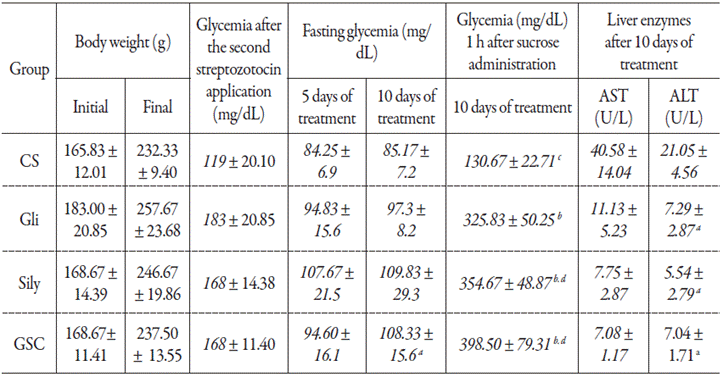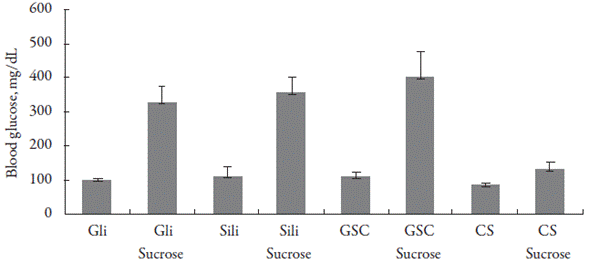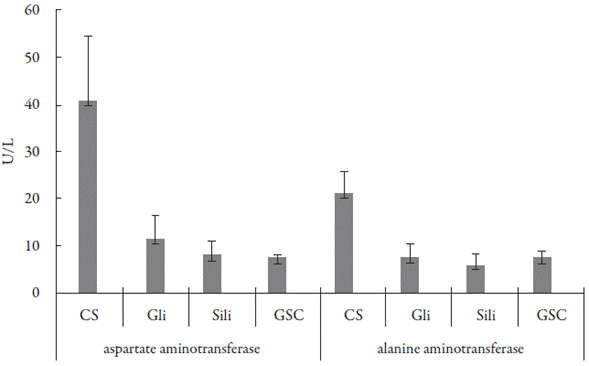INTRODUCTION
Diabetes mellitus (DM) is a syndrome characterized by impairment of carbohydrate, fat and protein metabolism. DM may be insulin dependent or non-insulin dependent when the tissues are less sensitive to the effect of insulin [1]. This is a public health topic and type 2 DM is the more common, with its complications representing one of the main causes of morbidity and mortality in the world [2,3]. Its origin is multifactorial and is related to genetic factors, diet and lifestyle [4]. In type 2 DM, insulin resistance in skeletal muscle and poor beta cell functioning can be detected several years before the diagnosis and are correlated with the incidence of cardiovascular disease. Some investigators have correlated inflammation and oxidative stress to DM and for this reason they support treatment with antioxidants, suggesting that they may have beneficial effects regarding the preservation of beta cell function [5].
The main characteristics of DM include high blood glucose levels (hyperglycemia) and disordered lipid, carbohydrate and protein metabolism, with prolonged exposure to hyperglycemia leading to the generation of free radicals that reduce the antioxidant defense of the organism and have negative consequences for health [6].
The diagnosis of DM is based on the parameters obtained by measuring urinary glucose, fasting glycemia and insulin levels and by applying the glucose tolerance test. In type 2 DM, plasma insulin concentration is higher than normal and increases in a more marked manner in the glucose tolerance test. [1] In general, type 2 DM is controlled by means of a rigorously controlled diet, regular physical activity and hypoglycemic therapy [4]. According to their mechanisms of action, antidiabetic drugs can be classified as those that increase pancreatic insulin secretion (sulfonylurea and glinides), those that reduce the rate of glucide absorption (alphaglycosidase inhibitors), those that reduce hepatic glucose production (biguanides), and those that increase the peripheral utilization of glucose (glitazones) [7].
DB is a progressive chronic disease that requires an ideal treatment at the onset. The pharmacological approach to DB treatment is centered on the achievement and maintenance of glycemic control. A patient-centered view should be employed to decide which pharmacological agents should be used, considering efficacy, side effects, comorbidities, the risk of hypoglycemia, cost, and patient weight and preference. DB treatment should include modifications of lifestyle, nutrition and the practice of regular physical activity [7].
As described by Stolf et al. [8], silymarin is a powder extract of the seeds of Silybum marianum, a plant belonging to the Asteraceae family. Its main active ingredients include four isomers, i.e. silybin, isosilybin, silychristin and silydianin. Silymarin is indicated for the treatment of hepatic diseases such as cirrhosis, chronic hepatitis and gallstones. In addition, the effects of silymarin have been tested in various studies of several diseases including DB, sepsis, osteoporosis, arthritis, hypercholesterolemia, cancer, viral infections, and Alzheimer and Parkinson diseases, with promising results. The usual adult dose is 70 to 140 mg, 3 times/day.
Ghobadi et al. [9] studied the effects ofsilymarin in models of hepatic injury due to thioacetamide and demonstrated hepatic hyperplasia. Lee et al. [10] considering the antimicrobial activity of silymarin, studied the nanoencapsulation of the product and reported improved antimicrobial activity that permitted its application to food additives and food packaging. Onaolapo et al. [11] investigated the impact of the oral administration of silymarin (25 mg/kg) on the changes induced by aspartame in behaviors elicited by novelty, in memory and in behaviors related to anxiety, in cerebral antioxidant status and in neural histomorphology in mice. The study demonstrated that coadministration of silymarin and aspartame was associated with a significant attenuation of the effects of the drugs on the central nervous system compared to the administration of aspartame alone.
Chromium picolinate is a type of chelated mineral that has been used as a food supplement although Lukaski et al. [12] in a study of dietary supplementation with chromium picolinate in women with controlled calorie intake and the maintenance of a balanced diet did not detect promising results in terms of weight loss. Another study concluded that dietary supplementation with chromium picolinate in rats with induced diabetes was effective in reducing the damage due to oxidative stress, suggesting a potential beneficial effect on diabetic patients [13]. Capsules containing 200 µg chromium picolinate are more commonly found in the US but, according to information obtained by Micromedex™, the dose can be as high as 1000 µg.
Chemically induced diabetes in an animal model is the universally accepted type of study preceding human trials. The objective is to elucidate the pharmacological action of substances used for the treatment of the disease, with streptozotocin (STZ) being used for this purpose. STZ is a glucoside isolated from Streptomyces achromogenes which stimulates the production of free radicals and leads to the destruction and disjunction of β cells of the pancreatic Langerhans islets within approximately three days. In general, a single dose of STZ, usually injected intraperitoneally, leads to insulin deficiency, although diabetes induction with STZ is not advisable in chronic studies because it can lead to tumor formation, especially in the kidneys and liver [14].
Several food supplements are freely sold in various countries in order to promote greater muscle mass gain and body fat loss, or even to increase insulin sensitivity. These supplements are probably used also by diabetics who regularly take medication for DM2. In a Serbian survey of about 500 diabetic patients, Damnjanovic et al. [15] observed that most of them used some medicinal plant in combination with their medication under the influence of doctors, pharmacists, friends, and the media. Thus, it can be seen that this practice occurs in several countries. The objective of the present study was to evaluate the effects of the oral administration of silymarin and chromium picolinate on standard treatment with glibenclamide for STZ-induced type-2 diabetes in male albino Wistar rats.
MATERIALS AND METHODS
Drugs and chemicals
The chemicals were obtained from the following manufacturers: silymarin (MP Biomedicals, EUA), chromium picolinate, glibenclamide, vincristine sulfate (Libbs FarmaceuticaTM, Brazil), and enzyme assay kit (LaborLabTM, Brazil). All other reagents used were of analytical grade and commercially obtained.
The elaborated formulations contained 0.06% polyethylene glycol 6000, 0.15% methyl-paraben, 0.05% propylparaben, 2.1% propylene glycol, and purified water (s.q. 100 g), with the addition of15 mg/mL silymarin, 3 mg/mL glibenclamide, or 15 mg/ml silymarin + 3 mg/mL glibenclamide + 1.87 µg/mL chromium picolinate). The formulations were stored in amber glass bottles and refrigerated at 5°C until the time for use.
Effects of the formulations on rats
Ethical aspects
The experimental protocols performed in this study were submitted to and approved by the Animal Research Ethics Committee, Pontifical Catholic University of Campinas (PUC Campinas) (Protocol number: 021/2017), according to the Guide for the Care and Use of Laboratory Animals. All applicable international, national, or institutional guidelines for the care and use of animals were followed.
Animals
Male non-isogenic albino Wistar rats (Rattus norvegicus) were obtained after weaning at the age of 30 days from the Multidisciplinary Center for Biological Investigation, Area of Laboratory Animal Science, of the Pontifical Catholic University of Campinas (PUC Campinas). The animals were housed under appropriate light and ventilation conditions and received appropriate rat chow (NuvilabTM, Brazil), with free access to water.
Diabetes induction
Diabetes mellitus was induced in two stages: first in overnight fasted rats by an intraperitoneal injection of STZ (45 mg/kg body weight) in sterilized 100 mM citrate buffer, pH 4.5 [14]. After three days, a second SZT dose (20 mg/kg body weight) was administered in sterilized 100 mM citrate buffer, pH 4.5, and fasting capillary glycemia was determined three days later.
Treatments
The rats were divided into four groups of 6 animals each. The treatments were administered by gastric gavage once a day for 10 days (table 1).
Table 1 Experimental groups and treatments.
| Group I | CS | Saline-treated nondiabetic control |
| Group II | Gli | 10 mg/kg glibenclamide, STZ |
| Group III | Sily | 50 mg/kg/day silymarin, STZ |
| Group IV | GSC | 50 mg/kg/day silymarin, 10 mg/kg glibenclamide and 5 fg/kg/day chromium picolinate, STZ |
STZ = overnight fasted rats receiving an intraperitoneal injection of streptozotocin
Capillary glycemia and enzyme determination
Twenty-four hours after the last dose, blood was collected from overnight fasted rats of each group for the determination of capillary glycemia under fasting conditions and 1 h after gavage with a 20% sucrose solution (0.5 mL). Blood glucose was determined in blood sample obtained from the caudal vein using a one touch glucometer (Accu-check®) [16]. Blood was then collected by cardiac puncture for the determination of alanine-aminotransferase (ALT) and aspartate aminotransferase (AST), using LaborLabTM kits. After the above procedure, the animals were euthanized with excess anesthesia with xylazine hydrochloride and ketamine solutions.
RESULTS AND DISCUSSION
No significant difference in body weight gain was observed between groups throughout the treatment period. The results obtained are presented in table 2 and in figures 1 and 2.
Table 2 Effects of treatment with silymarin, glibenclamide and chromium picolinate on body weight, glycemia and liver biochemical parameters of hyperglycemic and nonhyperglycemic rats.

Results are reported as mean ± SD (n=6)
a P < 0.005 compared to normal control group
b P < 0.001 compared to normal control group
c P < 0.001 compared to the values before gavage with sucrose
d P < 0.005 compared to normal control group 1 h after sucrose administration

Figure 1 Effect of treatment with silymarin (Sily, glibenclamide (Gli) and chromium picolinate for 10 days on fasting capillary glycemia (mg/dL) and on glycemia levels one hour after sucrose administration by gavage in hyperglycemic and nonhyperglycemic rats. CS: S'line-tre'ted healthy control; Gli: Diabetic group treated with glibenclamide (10 mg/kg/day); Sily: Diabetic group treated with silymarin (50 mg/kg/day); GSC: Diabetic group treated with glibenclamide (10 mg/kg/day), silymarin (50 mg/kg/day) and chromium picolinate (5 mg/kg/day).

Figure 2 Effect of treatment with silymarin (Sily), glibenclamide (Gli) and chromium picolinate for 10 days on hepatic transaminases in hyperglycemic and nonhyperglycemic rats. CS: Saline-treated healthy control; Gli: Diabetic group treated with glibenclamide (10 mg/kg/day); Sily: Diabetic group treated with silymarin (50 mg/kg/day); GSC: Diabetic group treated with glibenclamide (10 mg/kg/day), silymarin (50 mg/kg/day) and chromium picolinate (5 mg/kg/day).
Silymarin, one of the substances studied in the present investigation, has been used for the treatment of hepatic disorders, with reports attributing its benefits to its antioxidant properties [15]. Similarly, chromium picolinate is indicated by contributing to the reduction of blood glucose levels, with previous studies supporting its indication due to the increased insulin sensitivity induced by this substance in addition to its antioxidant activity [17].
In the present study, the expectation was that only a single STZ application would be sufficient to cause injury to pancreatic beta cells and to induce diabetes in the animals [18], a fact that, however, did not occur. Glycemia levels corresponding to type 2 DM were observed three days after the second STZ application (table 2), as later confirmed by the significant difference between fasting glycemia and glycemia levels 1 h after sucrose gavage observed only in the animals receiving STZ (figure 1).
Although the values were below 250 mg/dL [19], it was decided not to apply a further STZ dose since this third application might have caused very extensive damage to the insulin producing cells and the study would have been compromised if the animals had become insulin dependent. It should be pointed out that the action of STZ on pancreatic beta cells occurs in a gradual manner [20].
Increased water consumption during the treatment period was observed only in the animals injected with STZ. This behavior was expected since diabetic animals tend to consume large amounts of water.
The results of our study showed that the blood glucose of the GSC group was significantly increased compared to the healthy control group (CS) after ten days of treatment. We did not detect similar studies using a combination of these three substances for possible data comparison. Our results suggest that the association of silymarin and chromium picolinate reduced the antihyperglycemic effect of glibenclamide, although other authors have reported that each one of these substances, administered alone, can favor glycemic control [21, 22]. We believe that a longer treatment period would be important in future studies in order to determine whether this effect would be maintained. On the basis of the present results, the concomitant application of these compounds should be considered with caution. Treatment with silymarin normalized fasting capillary glycemia, with no difference between the silymarin and CS groups.
Our study revealed that, 1 hour after sucrose administration, the blood glucose of the Gli, Sily and GSC groups was significantly increased compared to the healthy CS group (table 2 and figure 1). In addition, when only the values obtained after sucrose administration were compared, only the Sily and GSC groups were found to differ from the CS group. This result suggests that previous silymarin treatment and the combination of silymarin, chromium picolinate and glibenclamide had the lowest effect on blood glucose control.
Statistical analysis indicated a reduction of blood transaminase levels in the treated groups, with equal result for the Sily, Gli and GSC regarding AST and ALT. These results may be explained by the fact that the present study was conducted over a period of ten day, i.e., an insufficient time to reveal the oxidative stress induced by DM2, without a sufficient increase in glycemia levels to cause extensive hepatic injury.
In a study by Kapoor and Kakkar [23] on rats with STZ-induced diabetes treated with Gli or Sily, the two substances were found to contribute to glycemia control and to reduce ALT and AST levels in diabetic animals.
Feng et al. [21] demonstrated that silymarin contributes to a reduction of insulin resistance and glucose intolerance due to a reduction of oxidative stress, a result similar to that reported by Nasri et al. [2], who attributed the effect of glycemia normalization of the compounds to their antioxidant action. Das et al. [24] encapsulated the bioactive compound of silymarin (silybin) and demonstrated its reduction of AST and ALT levels and its control of insulin levels in diabetic animals.
It was concluded that supplementation with 100 µg chromium picolinate twice a day [25] and with 70 µg once a day [21] contributed t glycemic control. Regarding liver protection, Sundaram et al. [13] revealed the potential of chromium picolinate to attenuate hyperglycemia-induced oxidative stress in experimental diabetes.
CONCLUSION
We may conclude that silymarin supplementation in combination with chromium picolinate for ten days reduced the efficacy of glibenclamide. It was observed that these substances significantly reduced the plasma levels of AST and ALT, indicating a hepatoprotective effect. In view of the fact that these substances are sold as supplements in many countries, their use should be considered with caution by persons on antidiabetic treatment. Further studies are suggested for the evaluation of the chronic effects of these supplements on these individuals.














